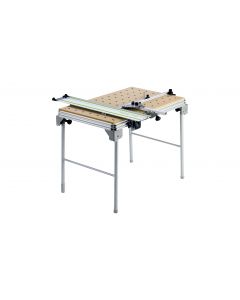How to use...
In action
Versions
DIY: How To Build a Workstation for a Table Saw
If you’re a tradesperson or a DIY woodworker with a table saw in your power tool collection, you likely need a workstation. A workstation is designed to house a table saw and enhance its functionality by improving its efficiency, accuracy, and safety, making it an invaluable addition to your workshop. The trick is finding the correct workstation for your projects; that’s why many people make their own. If you want a workstation tailored to your exact needs and your table saw, why not learn how to build a workstation for a table saw?
WHY YOU NEED A WORKSTATION FOR YOUR TABLE SAW
A workstation for a table saw is more than a convenience; it is essential. Workstations provide stability for improved accuracy and safety; they can make your workflow more efficient if they have built-in storage for additional tools, and they offer outfeed support for large workpieces to improve accuracy and prevent kickback.
Workstations that are built to the correct height help ensure you work without straining your body.
HOW TO PLAN YOUR WORKSTATION DESIGN
To begin, you’ll need to plan your workstation around the size of your workshop; there must be ample room for the workstation and to work comfortably.
Several other factors also require consideration.
Do you want built-in storage in your workbench, and what will you store?
Will your workstation be mobile or portable?
What material will you use to make it? Be aware that metal surfaces may trigger the saw stop technology on Festool table saws.
What is your budget? Designing a workstation can be demanding; consider buying a pre-made plan from woodworkers available online.
SEE ALSO:
- Plunge Cut Saws: A How-to-Use Guide
- How to put a blade on a circular saw
- How to Cut Straight Using a Circular Saw
- Plunge Cut Saws and Blade Size
- How to build a workstation for a table saw
- How to Cut a Board Straight with a Circular Saw
- How to use a Table Saw
- Circular Saws - how to change the blade
- Circular Saws - which way to install a blade
- Expert Insights: Table Saw Tips and Tricks from Professionals


ADDITIONAL WORKSTATION FEATURES
Various features will improve the functionality of your workstation. Beyond storage and casters for mobility, consider these useful and essential features.
Helpful table saw workstation features:
- Extendable work area for additional outfeed support, which can be folded down when not in use.
- A sliding carriage makes passing wood through the blade easier and improves accuracy.
- Additional mitre channels to position a rip fence as required.
- Built-in plug ports for easier access to electricity.
- Holes or recesses on the sliding carriage for clamps.
- A place for a dust extractor.


HOW TO BUILD YOUR WORKSTATION
Adjust the following steps as necessary since your design will influence the choice of materials, workflow, and construction time.
- Either design your workbench considering your needs or procure a suitable design. Add detail and include all measurements. Ensure the recess for the table saw is the correct size and depth by measuring its dimensions. It is also critical that the design allows the fence to slide unhindered along the table's edge.
- Gather the required materials such as plywood or MDF Boards, 2x4s, screws and nails, casters, wood glue, measuring tape, drill, saw, and other necessary tools. Additional materials may be required for more complex designs.
- Measure and cut your materials to the correct size according to your design. Remember to factor in the kerf of your blade when cutting your material to achieve precise results.
- Once cut, assemble the frame ensuring it is stable, load-bearing, and level.
- Install the top or work surface, ensure it’s flush with the frame and secure it with screws. Cut a hole to fit your table saw and install a board underneath to support it.
- Install drawers or shelves based on your design. Add handles and sliding rails to your materials list if you install storage. Sliding rails may also be helpful if you are installing a sliding carriage.
- Place the table saw into the cut-out and secure it to the supporting base. This will restrict movement for added precision and safety.
- If your workstation is to be mobile, install casters at the base of the table. For stability and safety, lockable casters are recommended.
- Add finishing touches by sanding rough areas, attaching handles, and varnishing the wood.
FESTOOL WORKSTATIONS
Along with a variety of high-quality table saws and accessories, Festool has a range of mobile workstations to choose from. Festool workstations are designed with ease of use and safety in mind to ensure projects achieve a professional finish. For additional functionality, there are various workstation accessories such as extensions, adjustable trimming attachments, and adjustable angle stops.
Building a workstation for your table saw is a significant step in improving your woodworking capabilities. With careful planning and the right tools, you can create a workspace that is functional and promotes efficiency and safety.
Whether you are planning to design your workstation from scratch or use a pre-made plan, Festool is here to provide the tools and accessories you need.





